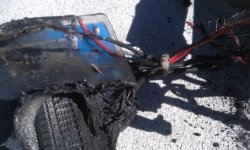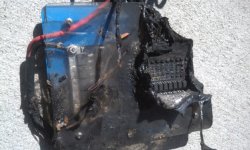Alan B
100 GW
dak664 said:A single fuse at the mid point gives the least bang for the buck.
I think he meant the "best" bang for the buck in terms of the "least" spark.
dak664 said:A single fuse at the mid point gives the least bang for the buck.


Alan B said:dak664 said:A single fuse at the mid point gives the least bang for the buck.
I think he meant the "best" bang for the buck in terms of the "least" spark.
chroot said:@Lyen, Thank you for the pictures. That one I bought it from ES member.
@deVries - There is none object or anything in the pannier bag except just only battery pack *isolated* inside. It was been since never change or anything. It never give me any trouble during the charging or ride rough on road daily.
@Alan B - The fuse rated is... hard to read due burnt. I tried look inside the fuse apparently did blow up. *Hard to see inside but can see the black marked from blow up*
Here the picture of fuse.
View attachment 1

deVries said:Alan B said:I think proper fusing is not really done frequently on these battery packs. I would like to see fuses on each hot lead coming out of the battery, but that is a lot of fuses.
This pack only needed 16 fuses to protect each cell from the other. Cheap insurance considering the alternatives. 8) Too bad the assembly design itself doesn't have the fuse built-in as "thin width" power connections, and then support the cells structurally by not using the power connections w/fuse design as support.
Jeremy Harris said:... when cold the fuses will lose over 30 watts.
In many cases this loss may be greater than the losses from cell internal resistance, but either way the battery pack is now going to run warmer than without the fuses, and heat is as much the enemy as vibration and chafing.
I'd suggest fixing the cause of vibration and chafing related failure, securing and properly insulating wires, cells and terminations, making sure the pack is properly protected from mechanical damage and using the right sort of insulation materials, not materials that creep and distort under mechanical stress and heat.
deVries said:What about the type of fuse that is "narrowed" & part of the actual "terminal connections" too, so you're not adding-in a replaceable 2-contact fuse with additional resistance connections?
Otherwise, your point proves there are better trade-offs in protecting the battery pack rather than using typical fuses for each cell, which, if used on each cell, will increase resistance & heat making the battery much less efficient.
Jeremy Harris said:deVries said:What about the type of fuse that is "narrowed" & part of the actual "terminal connections" too, so you're not adding-in a replaceable 2-contact fuse with additional resistance connections?
Otherwise, your point proves there are better trade-offs in protecting the battery pack rather than using typical fuses for each cell, which, if used on each cell, will increase resistance & heat making the battery much less efficient.
Unfortunately, a fuse, even a fusible link, relies on having a higher resistance than the wires and terminations in order to generate the heat needed to make it blow. If the fuse has a resistance comparable to the wires then it won't heat up enough to blow.
deVries said:Wouldn't there be a "happy medium" for protecting against a runaway reversal & high amp short that is still relatively low resistance? With these big Ah cells 16Ah or 20Ah or more I guess I get a bit "paranoid" about the heat-fire damage just one cell can do to create that cascade & total destruction scenario spreading to all cells going up in smoke or worse. :?
etriker said:Thos thread has me thinking fuses. Lots o fuses.
Dewalt A123 pack. Notice the connector made smaller.
http://i180.photobucket.com/albums/x218/biodiesel_2007/SUNP0032.jpg
Packs can take a beating on a ride. I know mine do sometimes.
Glad the kids caught the fire !
Jeremy Harris said:etriker said:Thos thread has me thinking fuses. Lots o fuses.
Dewalt A123 pack. Notice the connector made smaller.
http://i180.photobucket.com/albums/x218/biodiesel_2007/SUNP0032.jpg
Packs can take a beating on a ride. I know mine do sometimes.
Glad the kids caught the fire !
Fusible links, like that DeWalt one, are just a cheap bodge to avoid them having to find the space (and pay the money) to fit a proper fuse. They work, but I'm not convinced they are good practice, for the reason given above.
Similarly, lots of fuses may create more problems than it fixes, as I mentioned in a previous post.
Building packs to resist vibration and chafing and to tolerate the impacts they're likely to get on a bike is the best measure, with just a single fuse, maybe wired in to the centre of the pack but mounted externally.
dogman said:I'm still betting on a wire chafing on something while the battery bounced around in that bag. Then it shorted. Most likely culprit is the sharp edged bms rubbing on that wire that had all the insulation removed. In my book, that's likely to be the wire that took the dead short.
Fuses are good, but not as good as securing the battery, and putting some more chafe resistant cover on wires where they get close to something that can rub.
Tossed in a bag dont cut it.
kfong said:The type of wiring that can take abrasion is also a factor to concider. I know a lot of people like using the silicone wire sold by hobby king. It's good wire for heat resistance but it's lousy for abrasion resistance. I had a short in my Topeak bag right by the area where the wire exits the bag. I no longer use such wire in areas were wear can be affected. Automotive quality wires are best for such applications. Silicone sheathing can be easily torn by a sharp fingernail and wears down fast with abrasives, bad practice to use them.
etriker said:I like to take apart battery packs and see how others build them.
There is nothing cheap in those packs and are considered some of the best packs on the planet.
6 year old Dewalt packs that don't work still go for $30 and up on eBay.
I agree about building packs to resist vibration and chafing and to tolerate the impacts.
That is one reason I ride a trike. The extra lbs I added protecting the batteries made the whole battery setup heavy.
Dewalt dc9360 fire. http://www.google.com/search?q=dewalt+battery+pack+explodes&sourceid=ie7&rls=com.microsoft:en-us:IE-SearchBox&ie=&oe=#hl=en&gs_nf=1&gs_mss=dewalt%20d9360%20%20fire&pq=dewalt%209360%20%20fire&cp=9&gs_id=4d&xhr=t&q=dewalt+dc9360++fire&pf=p&rls=com.microsoft:en-us%3AIE-SearchBox&sclient=psy-ab&oq=dewalt+dc9360++fire&gs_l=&pbx=1&bav=on.2,or.r_gc.r_pw.r_qf.,cf.osb&fp=4600699899139f67&biw=1016&bih=563
Jeremy Harris said:etriker said:I like to take apart battery packs and see how others build them.
There is nothing cheap in those packs and are considered some of the best packs on the planet.
6 year old Dewalt packs that don't work still go for $30 and up on eBay.
I agree about building packs to resist vibration and chafing and to tolerate the impacts.
That is one reason I ride a trike. The extra lbs I added protecting the batteries made the whole battery setup heavy.
Dewalt dc9360 fire. http://www.google.com/search?q=dewalt+battery+pack+explodes&sourceid=ie7&rls=com.microsoft:en-us:IE-SearchBox&ie=&oe=#hl=en&gs_nf=1&gs_mss=dewalt%20d9360%20%20fire&pq=dewalt%209360%20%20fire&cp=9&gs_id=4d&xhr=t&q=dewalt+dc9360++fire&pf=p&rls=com.microsoft:en-us%3AIE-SearchBox&sclient=psy-ab&oq=dewalt+dc9360++fire&gs_l=&pbx=1&bav=on.2,or.r_gc.r_pw.r_qf.,cf.osb&fp=4600699899139f67&biw=1016&bih=563
I wasn't implying that the packs were cheap, just that a fusible link made by punching a narrow stip out of a connection tab is cheap, it's a lot, lot cheaper for the manufacturer to do this than add a separate fuse, and it takes up no extra space in the pack.
The fact remains that it's not as good as a fuse, as the current at which it will blow will be dependent on the heat that soaks out of that strip into the surrounding material. Also, when it blows it needs to be clear from anything that might catch fire, as that strip is going to be glowing white hot. I'm sure DeWalt sorted this in their design of their packs, but we don't have their R&D budget when building one-off packs and so cannot be at all sure that such a method would either work reliably or not be the cause of a fire. Imagine having a bit of flammable tape over that fusible link, or worse still, maybe some foam that would insulate it and let it get hot. DeWalt allow a mm or two of free space next to the fusible link, and ensure that the case is made of a either a thermoset or high melting point plastic.
etriker said:Been searching and can not find any info on a Dewalt DC9360 burning up. If one did I can not find it.
There must be thousands out there in use every day with cells made in 2006.
Surely a design worth study.
